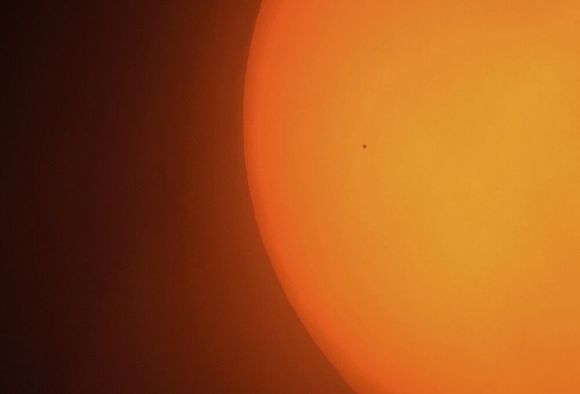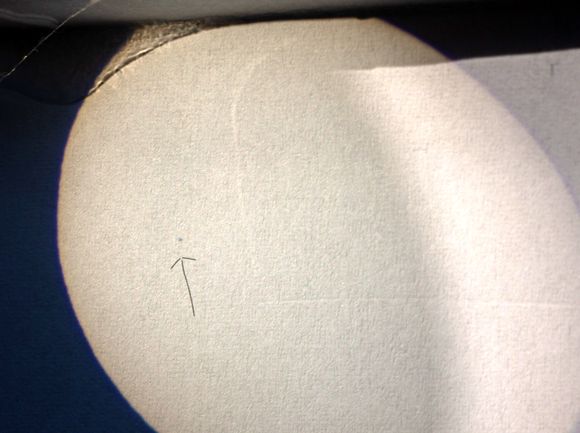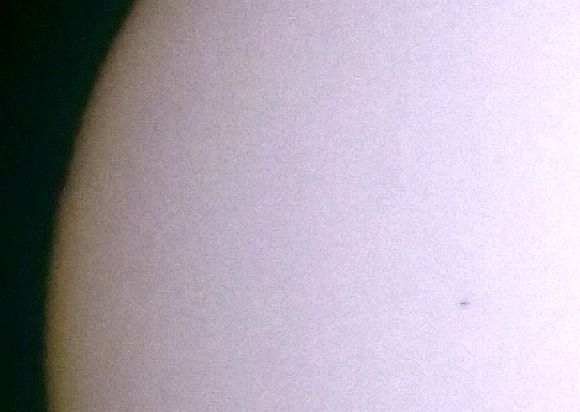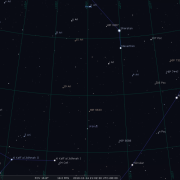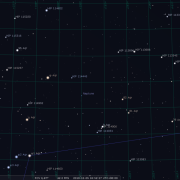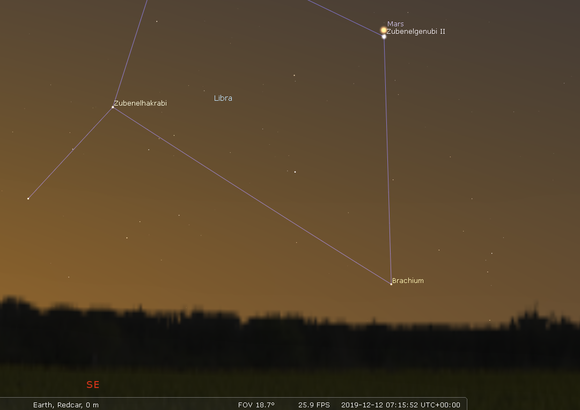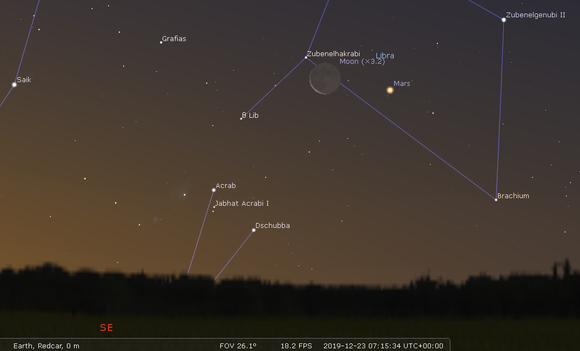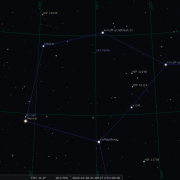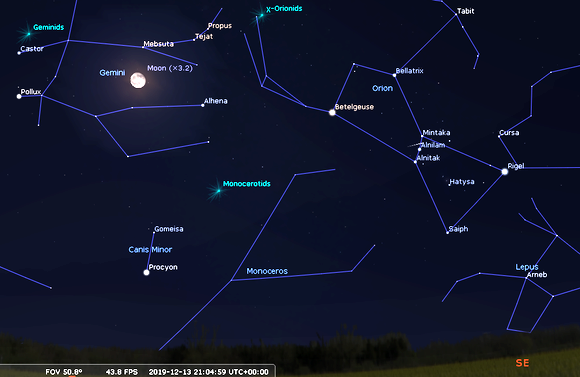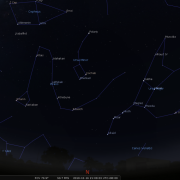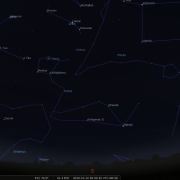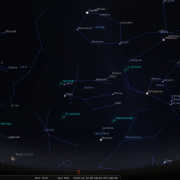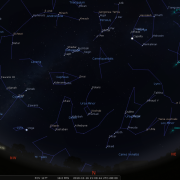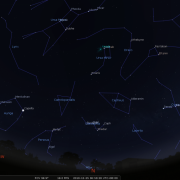Welcome to the WDAS monthly newsletter for December 2019: a digest of the month's latest contributions to our website. Below you'll find Society News: including the retirement of one of our oldest longest-serving Members, Members' pictures of the Transit of Mercury, the Christmas Dinner menu (yay!), and of course your monthly Sky Notes.
Society News
Well, it wasn’t a total cloud out for the transit of Mercury on Nov 11th after all, that said, the window of observing opportunity was limited to an hour or so during the early afternoon (at least from the Whitby and district area).
Several members did manage to get out and view the transit during this period, taking a few nice images of the event. The transit commenced shortly after 12:39h, with the tiny black dot of Mercury entering onto the disk of the Sun. Mid transit occurred after 15:00h, with the sun setting shortly after 16:00h with Mercury still in transit. The latter part of the transit was again obscured by cloud.
The images taken are from Paul Wood (colour) Paul used a nearly 50 yr old 3.5inch Questar with an attached full aperture solar filter and a smart phone with Celestron attachment clamped to the eyepiece.
The projected image is from Richard Randle using a spotter scope with the image projected onto a white card.
The two ‘phone camera to eyepiece’ images are from Elaine and Phil. They used a 66mm spotting scope with a 20x eyepiece and a Baader film solar filter. A smart phone was the imaging device. Taken from inside a darkened summerhouse room.
Transit of Mercury across the Sun on 11-Nov-2019. Picture by Paul Wood.
(Click for full-sized image) For more of Paul's images, see The Gallery.
Transit of Mercury across the Sun on 11-Nov-2019. Picture by Richard Randle.
(Click for full-sized image)
Transit of Mercury across the Sun on 11-Nov-2019. Picture by Elaine and Phil with a
phone camera. (Click for full-sized image) For another of Elaine & Phil's images, see The Gallery.
If you missed the transit (Mark did) there is a bit of a wait until the next one, in 2032!
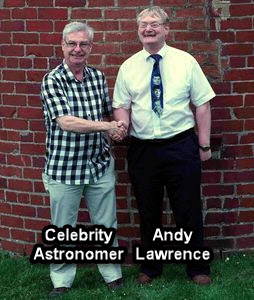 After working the thickest end of four decades at Fylingdales, society stalwart Andy Lawrence has finally vacated the work treadmill and retired. After starting at Fylingdales in a cleaning capacity before moving to the stores, Andy eventually finished as a materials controller.
After working the thickest end of four decades at Fylingdales, society stalwart Andy Lawrence has finally vacated the work treadmill and retired. After starting at Fylingdales in a cleaning capacity before moving to the stores, Andy eventually finished as a materials controller.
Andy and his wife Anne, who is also retiring from the Co-op, are looking forward to spending more time with their family, with a view to moving to Scotland next year. Our best wishes are extended, you lucky, lucky **d!
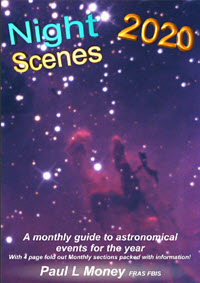 As of publishing we are still awaiting Night Scenes 2020, but they should be with us soon. We have ordered 25 copies and if you want to reserve a copy please contact Mark.
As of publishing we are still awaiting Night Scenes 2020, but they should be with us soon. We have ordered 25 copies and if you want to reserve a copy please contact Mark.
Stop Press: Night-Scenes have left the Printers! Hopefuly they will reach us in time for the WDAS December meeting. If not we will inform you when they do.
Reluctantly the price of Night Scenes has had to be increased slightly, but even at £5 (for Members) it still represents outstanding value.
 The Hare & Hounds at Hawsker will again be the venue for the Society Christmas meal. The date is December 14th at 19:00h. The meal has provisionally been booked for 9-12 people, so take a look at the menu (included) and if you are interested in a festive feast, please let Mark know your course choices at the December meeting. A menu will be passed around at the meeting, just in case. The Hare and Hounds require a list of choices a week before the date.
The Hare & Hounds at Hawsker will again be the venue for the Society Christmas meal. The date is December 14th at 19:00h. The meal has provisionally been booked for 9-12 people, so take a look at the menu (included) and if you are interested in a festive feast, please let Mark know your course choices at the December meeting. A menu will be passed around at the meeting, just in case. The Hare and Hounds require a list of choices a week before the date.
Christmas Menu
At the Hare and Hounds, Hawsker, Whitby YO22 4LH. Tel 01947 880453. Price:£25.
Starters:
- Homemade truffled parsnip soup, with crusty bread (V)
- The Hounds Black pudding scotch egg, with a red cabbage slaw
- Baked crab gratin pot, with a water cress and apple salad, and crusty bread
- Yorkshire blue cheese creme brûlée, with toasted rye bread and sun-blushed tomato and pesto soup
- Smooth chicken liver parfait, with crusty bread and fig compote.
To Follow:
- The Hounds own turkey ballotine, stuffed with pork & chestnut sausage meat, wrapped in streak bacon with creamed potatoes, rosemary roast potatoes and winter vegetables
- Slow roasted shin of beef, horseradish creamed potatoes, roasted root vegetables and a rich shallot gravy
- Chunk of cod on a pancetta & pea risotto with crispy shallots
- Butternut squash and sweet potato rösti with wilted spinach, hollandaise sauce and poached hen eggs (V)
- Salt crusted belly pork, with black pudding mashed potatoes, seasonal vegetables and cinnamon & apple glaze
- Chicken breast stuffed with haggis, served with a sweet potato fondant, streaky bacon and whiskey cream sauce
To Finish:
- Traditional Christmas pudding, served with homemade custard and a Sailor Jerry rum syrup
- Lemon and Lime Citrus Tart, wth a blueberry gin & tonic sorbet and winter berry coulis
- White chocolate drizzled profiteroles filled with orange & ginger cream
- The Hounds festive black forest Eton mess.
- Cheese platter, with a selection of biscuits and spiced cranberry chutney.
- The Society will be involved in several star party events in February coinciding with the half term ‘dark skies period from the 21st to the 28th.
- The Fox and Hound at Ainthorpe have teamed up with the Danby Moors centre for the 21st 22nd events.
- We will be at the Fox and Hounds Inn on the 21st and the Moors Centre the following evening. Details will be given in the January or February notes.
- On Feb 28th we have been invited by Angelique Russell to try again at Fylinghall School, hopefully with clearer skies this time. Again, further details will be forthcoming in the Jan/Feb notes.
Sky Notes
In this month's Sky Notes:
Planetary Skylights
Evening Planets
We bid farewell to two planets during December, with Jupiter and Saturn both departing the evening sky, whilst Venus starts to gain in altitude, growing ever more noticeable in the evening twilight. In the dawn sky, Mercury is still visible for the first ten days of December, whilst Mars continues to edge away from the South-East horizon.
 Jupiter is finally lost in solar glare by the end of the first week in December. If you have a clear unobstructed SW horizon you may just spot it half an hour after sunset before it drops below the horizon.
Jupiter is finally lost in solar glare by the end of the first week in December. If you have a clear unobstructed SW horizon you may just spot it half an hour after sunset before it drops below the horizon.
 Venus will grow ever more prominent in the December twilight sky, slowly pulling away from the SW horizon and moving up toward Saturn, which is sliding downwards. The two are closest on the 11th with Saturn upper right of Venus, whilst on the 14th they lie at an equal height above the horizon. View around 16:20h.
Venus will grow ever more prominent in the December twilight sky, slowly pulling away from the SW horizon and moving up toward Saturn, which is sliding downwards. The two are closest on the 11th with Saturn upper right of Venus, whilst on the 14th they lie at an equal height above the horizon. View around 16:20h.

 Saturn continues to slide down toward the horizon and is lost by the end of the month. Look for a very slender crescent Moon in this part of the evening sky from the 27th to 29th.
Saturn continues to slide down toward the horizon and is lost by the end of the month. Look for a very slender crescent Moon in this part of the evening sky from the 27th to 29th.
 Uranus resides in Aries well placed in the SSE during the evening. Although technically visible to the naked eye at Mag +5.8, in reality binoculars, or better still, a telescope are needed to spot it. Uranus resides just within the borders of Aries quite some distance below the ‘crooked line’ asterism of the Ram. If you have a constellation chart or App etc, use Mesarthim and Iota Aries as pointers to locate Uranus, which resides 3 times the distance between these stars and a tad to the right, below them. Through a telescope Uranus resembles a very small disk of subtle grey/green hue.
Uranus resides in Aries well placed in the SSE during the evening. Although technically visible to the naked eye at Mag +5.8, in reality binoculars, or better still, a telescope are needed to spot it. Uranus resides just within the borders of Aries quite some distance below the ‘crooked line’ asterism of the Ram. If you have a constellation chart or App etc, use Mesarthim and Iota Aries as pointers to locate Uranus, which resides 3 times the distance between these stars and a tad to the right, below them. Through a telescope Uranus resembles a very small disk of subtle grey/green hue.
 Neptune resides in the constellation of Aquarius just under a degree lower right of the star phi aqr. You will require a telescope to spot its diminutive disk, which is fainter than all visible naked eye stars, but it does appear blue/grey in hue.
Neptune resides in the constellation of Aquarius just under a degree lower right of the star phi aqr. You will require a telescope to spot its diminutive disk, which is fainter than all visible naked eye stars, but it does appear blue/grey in hue.
Morning Planets
 At the start of December Mercury is actually the second brightest planet on view, and certainly the brightest in the morning sky, but you will require a clear view of the SE horizon to spot it. As the month commences it resides over eight degrees above the horizon, (a tad more than the average 7 x 50 binocular field) but rapidly drops backwards and will be lost once again by the 11th. You will need to view around 07:15h.
At the start of December Mercury is actually the second brightest planet on view, and certainly the brightest in the morning sky, but you will require a clear view of the SE horizon to spot it. As the month commences it resides over eight degrees above the horizon, (a tad more than the average 7 x 50 binocular field) but rapidly drops backwards and will be lost once again by the 11th. You will need to view around 07:15h.
04-Dec-2019 at 07:11h (SE): Mars and Mercury. (Click for full-sized image)
12-Dec-2019 at 07:15h (SE): Mars and Zubenelgenubi. (Click for full-sized image)
23-Dec-2019 at 07:15h (SE): The Moon and Mars. (Click for full-sized image)
 Mars resides upper right of Mercury at the start of December and is slowly moving diagonally away from the SE horizon when viewed at the same time each morning, although it is actually moving down through the stars of Libra. It is the Earth’s daily rotation which compensates for this. On the 12th Mars lies very close to the lovely double star Alpha Libra or Zuben Elgenubi. Binoculars or a telescope will show them well. Look for the crescent moon in this area of the sky on the 22nd and 23rd.
Mars resides upper right of Mercury at the start of December and is slowly moving diagonally away from the SE horizon when viewed at the same time each morning, although it is actually moving down through the stars of Libra. It is the Earth’s daily rotation which compensates for this. On the 12th Mars lies very close to the lovely double star Alpha Libra or Zuben Elgenubi. Binoculars or a telescope will show them well. Look for the crescent moon in this area of the sky on the 22nd and 23rd.
 The minor planet Vesta remains well placed for spotting, residing in the loop of mostly faint stars marking the head of Cetus. Look for it toward the top of the loop not far below mu ceti. At mag + 7.5 Vesta is now beyond naked eye visibility, but binoculars will suffice, with its motion against the background stars betraying its nature. Consecutive observing nights would therefore be helpfull!
The minor planet Vesta remains well placed for spotting, residing in the loop of mostly faint stars marking the head of Cetus. Look for it toward the top of the loop not far below mu ceti. At mag + 7.5 Vesta is now beyond naked eye visibility, but binoculars will suffice, with its motion against the background stars betraying its nature. Consecutive observing nights would therefore be helpfull!
Meteors

Considered the most prolific annual meteor shower, the Geminids are active from December 7-16th, reaching a peak on December 14th. When conditions are favourable observed rates can approach 50-60 per hour, however this year a waning gibbous moon will severely restrict numbers and only the brightest Geminids will be noticeable.
Geminids originate from debris shed by a small asteroid called Phaethon, which may even be the nucleus of a ‘dead’ comet. Phaethon passes within ten million miles of the Sun causing the object to deposit material over great swathes of the inner solar system. However it is only within the last eighty years that Geminid activity has increased to the levels now recorded, a result of Earth passing through a much denser debris strand, a situation that will only continue for another hundred years or so.
A typical Geminid meteoroid is about the size of a large coffee granule, Brighter Geminids regularly produce long luminous trails, sometimes green or orange in hue. The shower radiant lies close to Castor, visible in the east by 21:00h.
Conditions for the less prolific Ursid meteor shower are much more favourable. The shower is active from Dec 17-25th, peaking on Dec 22/23rd, Hourly rates of around 10 are the norm, but occasionally and erratically, Ursids can produce strong outbursts, so it may be worth keeping an eye open that night. The radiant lies close to the Great Bear – Ursa Major.
The Winter Solstice

Winter Solstice in Winksley, North Yorkshire
back in 1998. Photo by Peter Crump.
The Sun reaches its lowest position in the sky on December 22nd, the date of the winter solstice and officially the start of winter in the northern hemisphere. From our latitude, useful daylight amounts to just 7½ hrs ’the shortest day’.
Latest sunrise and earliest sunset do not however occur on the winter solstice date. The Sun sets earliest mid-month (15 or 16th) and rises latest near the end of December (27 or 28th).
|
Looking North
Mid-December - 21:00h |
Looking South |
|
Looking East
Mid-December - 21:00h |
Looking West
Mid-December - 21:00h |
|
Northern Aspect
Mid-December - 20:00h |
Southern Aspect
Mid-December - 21:00h |
|
Looking North (Early)
Christmas Day - 07:00h |
Looking South (Early)
Christmas Day - 07:00h |
Additional Image Credits:
- Planets and Comets where not otherwise mentioned: NASA
- Sky Charts: Stellarium Software
Events
 Observe the night sky with us at the Bruce Observatory, Whitby School
Observe the night sky with us at the Bruce Observatory, Whitby School
Observing Nights are held weather permitting: check for a relatively clear sky before leaving home. If in doubt, Mark can be reached on 07886069339
Please note the college drive gate is now operated via a electronic key code - so anyone wishing to attend must be at the car park at the top of the drive by 19:00hrs - unless an arrival time has been arranged with Mark/Keith.
 Observe the night sky with us at the Bruce Observatory, Whitby School
Observe the night sky with us at the Bruce Observatory, Whitby School
Observing Nights are held weather permitting: check for a relatively clear sky before leaving home. If in doubt, Mark can be reached on 07886069339
Please note the college drive gate is now operated via a electronic key code - so anyone wishing to attend must be at the car park at the top of the drive by 19:00hrs - unless an arrival time has been arranged with Mark/Keith.

